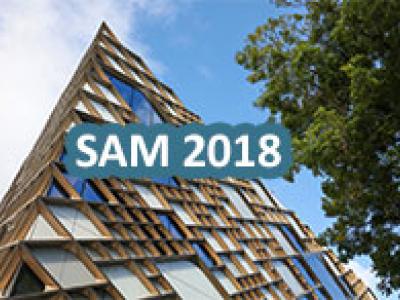
- Read more about FREQUENCY-DOMAIN DECOUPLING FOR MIMO-GFDM SPATIAL MULTIPLEXING
- Log in to post comments
Generalized frequency division multiplexing (GFDM) is considered a nonorthogonal waveform and can cause difficulties when used in the spatial multiplexing mode of a multiple-input-multiple-output (MIMO) scenario. In this paper, a class of GFDM prototype filters, in which the GFDM system is free from inter subcarrier interference, is investigated, enabling frequency-domain decoupling during processing at the GFDM receiver. An efficient MIMO-GFDM detection method based on depth-first sphere decoding is subsequently proposed with this class of filters.
- Categories:
 45 Views
45 Views
- Read more about SPARSE BLIND DEMIXING FOR LOW-LATENCY SIGNAL RECOVERY IN MASSIVE CONNECTIVITY
- Log in to post comments
Internet-of-Things (IoT) networks are envisioned to typically
include a massive number of devices with sporadic and low-latency
uplink service needs. This paper presents a blind
demixing approach to support the data recovery of multiple
simultaneous and unscheduled device transmissions without
a priori channel state information (CSI). The proposed joint
receiver leverages the group sparse bilinear characteristics
of the underlying problem that involves active device detection
and data recovery. We exploit the manifold geometry
- Categories:
 47 Views
47 Views
- Read more about SPARSE BLIND DEMIXING FOR LOW-LATENCY SIGNAL RECOVERY IN MASSIVE CONNECTIVITY
- Log in to post comments
Internet-of-Things (IoT) networks are envisioned to typically
include a massive number of devices with sporadic and low-latency
uplink service needs. This paper presents a blind
demixing approach to support the data recovery of multiple
simultaneous and unscheduled device transmissions without
a priori channel state information (CSI). The proposed joint
receiver leverages the group sparse bilinear characteristics
of the underlying problem that involves active device detection
and data recovery. We exploit the manifold geometry
- Categories:
 37 Views
37 Views
- Read more about Cryptographic Side-Channel Signaling and Authentication via Fingerprint Embedding
- Log in to post comments
We describe a general framework for designing and embedding a fingerprint at the physical layer of a wireless network to achieve authentication with enhanced security and stealth. Fingerprint embedding is a key-aided process of superimposing a low-power tag to the primary message waveform for the purpose of authenticating the transmission. The tag is uniquely created from the message and key, and successful authentication is achieved when the correct tag is detected by the receiver.
- Categories:
 51 Views
51 Views

- Read more about Polar Feature Based Deep Architectures for Automatic Modulation Classification Considering Channel Fading
- Log in to post comments
To develop intelligent receivers, automatic modulation classification (AMC) plays an important role for better spectrum utilization. The emerging deep learning (DL) technique has received much attention in AMC due to its superior performance in classifying data with deep structure. In this work, a novel polar-based deep learning architecture with channel compensation network (CCN) is proposed. Our test results show that learning features from polar domain (r-θ) can improve recognition accuracy by 5% and reduce training overhead by 48%.
- Categories:
 11 Views
11 Views
- Read more about RANDOMIZED METHOD FOR ESTIMATING THE VON NEUMANN ENTROPY OF LARGE-SCALE DENSITY MATRICES
- Log in to post comments
- Categories:
 8 Views
8 Views
- Read more about PHYSICAL LAYER ABSTRACTION FOR PERFORMANCE EVALUATION OF LEO SATELLITE SYSTEM FOR IOT USING TIME-FREQUENCY ALOHA SCHEME
- Log in to post comments
One of the main issues in using a Low Earth Orbit (LEO) satellite constellation to extend a Low-Powered Wide Area Network is the frequency synchronization. Using a link based on random access solves this concern, but also prevents delivery guarantees,
and implies less predictable performance. This paper concerns the estimation of Bit Error Rate (BER) and Packet Error Rate (PER) using physical layer abstractions under a time and frequency random scheme, namely Time and Frequency Aloha. We first derive a BER
- Categories:
 18 Views
18 Views
- Read more about IMPLEMENTATION OF A HDL-CODER BASED TELECOMMAND RECEIVER APPLICATION FOR MICROSATELLITE COMMUNICATION
- Log in to post comments
In this paper the development and implementation of a Telecommand (TC) receiver application for microsatellite
communication is presented. The TC receiver application is executed and operated by a highly integrated Generic
Software-Defined Radio (GSDR) platform. This platform architecture is designed for the reliable operation of
multiple radio frequency applications on spacecraft. For the development and implementation process of the TC receiver application, a new model-based development workflow by Matlab/Simulink is used and evaluated
- Categories:
 9 Views
9 Views
- Read more about Underwater Trajectory Estimation based on Grid Localization and Smoothing
- Log in to post comments
Li_SAM2018.pdf
- Categories:
 3 Views
3 Views